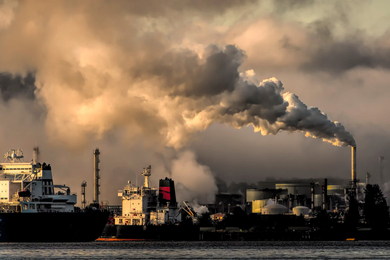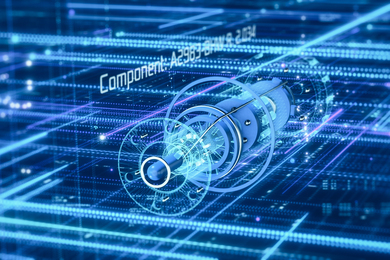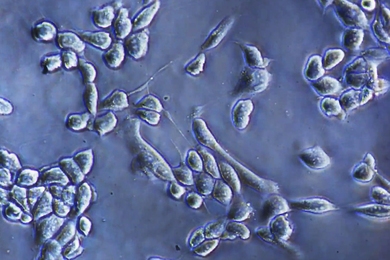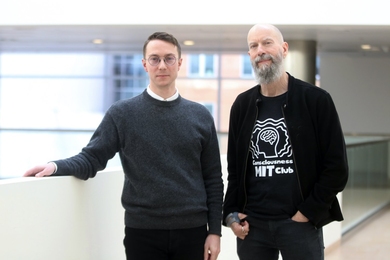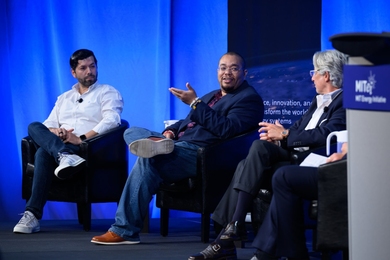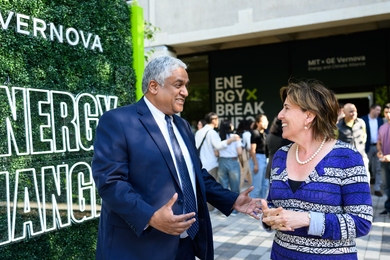Clifford Goudey has become something of an urban farmer, but don't look for him milking cows or tending cattle amidst the Hub's skyscrapers. The citified husbandry that's caught his eye is aquaculture, and he's now raising fish in Boston Harbor.
Why grow fish in Boston Harbor? "Because we can," said Goudey, director of MIT Sea Grant's Center for Fisheries Engineering. "It would have been preposterous 10 years ago, but the water quality has improved tremendously, and it's getting better."
To prove that point, Mr. Goudey started Aqualab, the first aquaculture project in Boston Harbor. Perched on a pier at the National Park Service's Charlestown Navy Yard, this compact, year-round research facility is helping to identify and solve critical problems restraining the growth of aquaculture in Boston Harbor and other coastal urban centers.
"We're trying to study the implications of growing finfish in the harbor, where there may be some trace contamination from pollution," Mr. Goudey explained. Having started out with cod fingerlings, he will be raising hearty, warm-water red drum this summer. The fish will then be examined for accumulation of metals or other contaminants. But he is optimistic about what those inspections will reveal. "Most of the lingering contamination in the harbor is in the sediments, not in the water column," he said. "The water quality here is among the highest for urban harbors."
Thus, the lab can serve as a model for larger-scale commercial ventures in the lucrative worldwide aquaculture industry valued at more than $30 billion. Although Aqualab's systems are small, they are as complex as those used in similar commercial systems. The facility is housed in a 20-by-8-foot cargo van and includes two recirculating systems, each with a 300-gallon tank for growing fish. The water is pumped into the tanks from the harbor, with approximately 10 percent of the water replaced daily. Water quality is maintained with a protein skinner, a floating bead filter and an ultraviolet sterilizer.
"Bacteria that grow on the beads break down the ammonia produced by fish into benign compounds, and these are removed in the water exchange process," said Mr. Goudey. The protein skimmer also removes fine particles from the water to improve clarity. The water is moved through this system and aerated by an airlift pump.
The project is also educational on a number of levels. Students from the Department of Ocean Engineering helped construct and install the lab, and they're gaining hands-on experience in maintaining the fish.
Public education at the site is also a key element to Aqualab. "There is a lot of misinformation about aquaculture," Mr. Goudey said. "In some respects, the bad rap is earned because there are some very irresponsible examples that have turned mangrove forests into environmental nightmares or polluted coastal embayments through poor husbandry practices." However, recirculating systems such as the one used at Aqualab provide growers with good control of water quality, and effluent can be treated before it is released back into the environment.
These points comprise part of Aqualab's interpretive introduction to aquaculture, which is on display for visitors to the Charlestown Navy Yard. As home to the USS Constitution, the site welcomes more than 2 million people each year.
"Whenever we're down here, people are always coming by and asking questions," said Mr. Goudey. "They've been very supportive of both the aquaculture efforts and associated outreach activities we have held." Along with technical information, visitors also get a broader understanding of the potential economic gains from aquaculture in Boston Harbor and off the Massachusetts coast.
Across the harbor, Boston Mayor Thomas Menino has also shown interest in Mr. Goudey's efforts. "The Mayor's office has initiated work to try to bring aquaculture to Boston Harbor," said Mr. Goudey. He's now doing a study for the city to assess the feasibility of using Boston Harbor's Moon Island -- once a sewage treatment site -- as an aquaculture center. Discussions are also ongoing with Massport and other property owners about other possible sites for projects on the inner harbor.
Until then, Mr. Goudey will be busy raising fish at Aqualab, hoping to spark growth in the production of seafood. "I think there's a strong market for different kinds of high-quality products here, and the harbor makes perfect sense for this," he said. "Boston is one of many coastal cities that has a great harbor but also has a lot of underutilized waterfront industrial space."
Some of that space has already been converted to non-maritime and residential activity. According to Mr. Goudey, the time is ripe to devote some of that space to raising fish. "In the next 10 to 20 years, either aquaculture makes a stand and gets part of the waterfront, or it never will."
(This article originally appeared in Two If By Sea, a joint publication of the MIT and Woods Hole Oceanographic Institution Sea Grant programs.)
A version of this article appeared in MIT Tech Talk on December 10, 1997.
